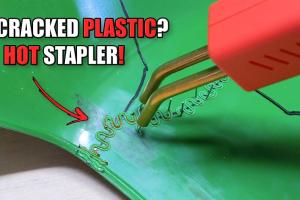Ultimate Guide to Repairing Cracks in Plastic: Step-by-Step Solutions

-
Quick Links:
- 1. Introduction
- 2. Understanding Plastic
- 3. Common Types of Plastic Cracks
- 4. Tools and Materials Needed
- 5. Repair Methods
- 6. Step-by-Step Guide to Repairing Cracks
- 7. Case Studies
- 8. Expert Insights
- 9. FAQs
- 10. Conclusion
1. Introduction
Plastic is a versatile material used in a wide array of products, from household items to automotive parts. However, its durability can sometimes be compromised due to cracks. This comprehensive guide will teach you how to effectively repair cracks in plastic, saving you time and money while extending the life of your items.
2. Understanding Plastic
Plastic is a synthetic material made from polymers. It can be classified into various types, including thermoplastics and thermosetting plastics. Understanding the type of plastic you are dealing with is crucial for choosing the right repair method.
3. Common Types of Plastic Cracks
- Surface Cracks: These are minor cracks on the surface and are usually easy to repair.
- Structural Cracks: These cracks compromise the strength of the plastic and require more intensive repair methods.
- Stress Cracks: Often caused by environmental factors, these cracks can propagate quickly if not addressed.
4. Tools and Materials Needed
Having the right tools and materials is essential for a successful repair. Here’s a list of what you might need:
- Plastic adhesive
- Epoxy resin
- Heat gun
- Plastic filler
- Sandpaper
- Clamps
- Protective gear (gloves, goggles)
5. Repair Methods
5.1 Adhesives
Using a strong adhesive is one of the simplest ways to repair cracks in plastic. Look for cyanoacrylate or polyurethane-based adhesives for effective bonding.
5.2 Plastic Welding
This method involves melting the plastic along the crack and fusing it together. It’s particularly useful for structural cracks.
5.3 Epoxy Resins
Epoxy resins are excellent for filling cracks and adding strength. They are particularly effective for larger or deeper cracks.
5.4 Heat Gun Repairs
Using a heat gun can help reshape and repair plastic items by softening the material around the crack.
5.5 Filler Materials
Filler materials can be used to level out surfaces and fill larger cracks before applying adhesive or resin.
6. Step-by-Step Guide to Repairing Cracks
- Assess the Damage: Determine the type and extent of the crack.
- Clean the Area: Remove any dirt or debris from the crack.
- Choose a Repair Method: Based on the type of crack, select an appropriate repair method.
- Prepare the Adhesive or Filler: Follow the manufacturer's instructions for mixing or applying the repair material.
- Apply the Repair Material: Fill or bond the crack as necessary.
- Let it Cure: Allow the repair to set according to the product instructions.
- Sand and Finish: Once cured, sand the area smooth and apply any finishing touches.
7. Case Studies
Here are a few real-world examples of successful plastic repairs:
- Case Study 1: A homeowner repaired a cracked patio chair using epoxy resin and was able to restore its strength.
- Case Study 2: A car enthusiast successfully welded a cracked bumper, saving hundreds in replacement costs.
8. Expert Insights
According to plastic repair specialists, the key to a successful repair is in the preparation and selection of materials. Plastics News suggests testing the adhesive on a small area first to ensure compatibility.
9. FAQs
What types of plastic can be repaired?
Most common plastics like PVC, ABS, and polycarbonate can be repaired using appropriate methods.
How do I know what adhesive to use?
Check the manufacturer's recommendations and ensure the adhesive is compatible with the type of plastic.
Can I use super glue for repairing plastic?
Yes, cyanoacrylate (super glue) works well for small cracks and quick fixes.
Is plastic welding permanent?
Yes, when done correctly, plastic welding can create a strong, permanent bond.
What safety precautions should I take?
Always wear gloves and goggles when working with adhesives and heat tools.
How long does it take for adhesive to cure?
This varies by product, but most adhesives take 24 hours to fully cure.
Can I paint over repaired plastic?
Yes, once the repair is fully cured and sanded smooth, you can paint over it.
What if my repair fails?
If the repair fails, you can often reapply or choose a different method for repair.
Are there professional services for plastic repair?
Yes, many automotive and furniture repair shops specialize in plastic repairs.
Can I repair large cracks in plastic?
Yes, larger cracks can be repaired using fillers and adhesives, though they may require more thorough preparation.
10. Conclusion
Repairing cracks in plastic is not only cost-effective but also an environmentally friendly option to prolong the life of your items. By following the methods and steps outlined in this guide, you can confidently tackle any plastic repair project.
Random Reads
- Ways to view download pdf iphone
- Watch youtube on tv
- Wake unlock ipad
- How to wash marble floors
- How to watch movies using telnet
- How to minimize all open windows without windows button
- How to mix gold color paint
- How to use post it notes on mac desktop
- How to use ps3 controller on pc
- How to make bookshelf minecraft